Novel Strategies against Cancer: Dexibuprofen-Loaded Nanostructured Lipid Carriers
Abstract
:1. Introduction
2. Results and Discussion
2.1. Preformulation Studies
2.2. Optimization of Dexibuprofen–Nanostructured Lipid Carriers
2.3. DXI-NLC Characterization Studies
2.4. In Vitro Drug Release
2.5. Short-Term Storage Stability
2.6. Effect of Gamma Radiation
2.7. Cytotoxicity of Fabricated Formulation towards Selected Cancer Cell Lines
3. Materials and Methods
3.1. Chemicals and Reagents
3.2. Methods
3.2.1. Preparation of Nanostructured Lipid Carriers
3.2.2. Physicochemical Characterization of Nanostructured Lipid Carriers
3.2.3. Optimization of Nanostructured Lipid Carrier Parameters
3.2.4. Interaction Studies and Nanosphere Characterization
Differential Scanning Calorimetry
Fourier-Transform Infrared Spectroscopy
X-ray Diffraction
Transmission Electron Microscopy
3.2.5. In Vitro Drug Release
3.2.6. Short-Term Stability of Solid Lipid Nanoparticles
3.2.7. Sterilization by Gamma Radiation
3.2.8. In Vitro Cytotoxicity Assay
Cell Lines
Determination of Antiproliferative Activity
3.2.9. Statistics
4. Conclusions
Author Contributions
Funding
Institutional Review Board Statement
Informed Consent Statement
Conflicts of Interest
References
- Sung, H.; Ferlay, J.; Siegel, R.L.; Laversanne, M.; Soerjomataram, I.; Jemal, A.; Bray, F. Global Cancer Statistics 2020: GLOBOCAN Estimates of Incidence and Mortality Worldwide for 36 Cancers in 185 Countries. CA. Cancer J. Clin. 2021, 71, 209–249. [Google Scholar] [CrossRef]
- FDA. Novel Drug Approvals for 2021; FDA: Silver Spring, MD, USA, 2021. [Google Scholar]
- FDA. Novel Drug Approvals for 2020; FDA: Silver Spring, MD, USA, 2020. [Google Scholar]
- Meegan, M.J.; O’Boyle, N.M. Special Issue “Anticancer Drugs 2021”. Pharmaceuticals 2022, 15, 479. [Google Scholar] [CrossRef] [PubMed]
- Brown, K. Repurposing Old Drugs for New Uses. DePaul J. Art Technol. Intellect. Prop. Law 2019, 28, 1. [Google Scholar]
- DiMasi, J.A.; Hansen, R.W.; Grabowski, H.G. The price of innovation: New estimates of drug development costs. J. Health Econ. 2003, 22, 151–185. [Google Scholar] [CrossRef]
- Wong, R.S.Y. Role of Nonsteroidal Anti-Inflammatory Drugs (NSAIDs) in Cancer Prevention and Cancer Promotion. Adv. Pharmacol. Sci. 2019, 2019, 3418975. [Google Scholar] [CrossRef] [PubMed]
- Manrique-Moreno, M.; Heinbockel, L.; Suwalsky, M.; Garidel, P.; Brandenburg, K. Biophysical study of the non-steroidal anti-inflammatory drugs (NSAID) ibuprofen, naproxen and diclofenac with phosphatidylserine bilayer membranes. Biochim. Biophys. Acta 2016, 1858, 2123–2131. [Google Scholar] [CrossRef]
- Pollard, M.; Luckert, P.H.; Schmidt, M.A. The suppressive effect of piroxicam on autochthonous intestinal tumors in the rat. Cancer Lett. 1983, 21, 57–61. [Google Scholar] [CrossRef]
- Harris, R.E.; Chlebowski, R.T.; Jackson, R.D.; Frid, D.J.; Ascenseo, J.L.; Anderson, G.; Loar, A.; Rodabough, R.J.; White, E.; Mctiernan, A. Breast Cancer and Nonsteroidal Anti-Inflammatory Drugs: Prospective Results from the Women’s Health Initiative 1. CANCER Res. 2003, 63, 6096–6101. [Google Scholar]
- Makins, R.; Ballinger, A. Gastrointestinal side effects of drugs. Expert Opin. Drug Saf. 2003, 2, 421–429. [Google Scholar] [CrossRef]
- Greenspan, E.J.; Madigan, J.P.; Boardman, L.A.; Rosenberg, D.W. Ibuprofen inhibits activation of nuclear β-catenin in human colon adenomas and induces the phosphorylation of GSK-3β. Cancer Prev. Res. 2011, 4, 161–171. [Google Scholar] [CrossRef]
- Chai, A.C.; Robinson, A.L.; Chai, K.X.; Chen, L.M. Ibuprofen regulates the expression and function of membrane-associated serine proteases prostasin and matriptase. BMC Cancer 2015, 15, 1025. [Google Scholar] [CrossRef] [PubMed]
- Gliszczyńska, A.; Sánchez-López, E. Dexibuprofen Therapeutic Advances: Prodrugs and Nanotechnological Formulations. Pharmaceutics 2021, 13, 414. [Google Scholar] [CrossRef] [PubMed]
- Almeida, H.; Lobão, P.; Frigerio, C.; Fonseca, J.; Silva, R.; Sousa Lobo, J.M.; Amaral, M.H. Preparation, characterization and biocompatibility studies of thermoresponsive eyedrops based on the combination of nanostructured lipid carriers (NLC) and the polymer Pluronic F-127 for controlled delivery of ibuprofen. Pharm. Dev. Technol. 2017, 22, 336–349. [Google Scholar] [CrossRef] [PubMed]
- Sütő, B.; Berkó, S.; Kozma, G.; Kukovecz, Á.; Budai-Szucs, M.; Erös, G.; Kemény, L.; Sztojkov-Ivanov, A.; Gáspár, R.; Csányi, E. Development of ibuprofen-loaded nanostructured lipid carrier-based gels: Characterization and investigation of in vitro and in vivo penetration through the skin. Int. J. Nanomed. 2016, 11, 1201–1212. [Google Scholar] [CrossRef]
- Süto, B.; Weber, S.; Zimmer, A.; Farkas, G.; Kelemen, A.; Budai-Szucs, M.; Berkó, S.; Szabó-Révész, P.; Csányi, E. Optimization and design of an ibuprofen-loaded nanostructured lipid carrier with a 23 full factorial design. Chem. Eng. Res. Des. 2015, 104, 488–496. [Google Scholar] [CrossRef]
- Sánchez-López, E.; Espina, M.; Doktorovova, S.; Souto, E.B.; García, M.L. Lipid nanoparticles (SLN, NLC): Overcoming the anatomical and physiological barriers of the eye—Part II—Ocular drug-loaded lipid nanoparticles. Eur. J. Pharm. Biopharm. 2017, 110, 58–69. [Google Scholar] [CrossRef]
- Souto, E.B. Lipid Nanocarriers in Cancer Diagnosis and Therapy; Smithers Rapra: Shrewsbury, UK, 2011; ISBN 9781847354785. [Google Scholar]
- Martins, S.; Sarmento, B.; Ferreira, D.C.; Souto, E.B. Lipid-based colloidal carriers for peptide and protein delivery—Liposomes versus lipid nanoparticles. Int. J. Nanomed. 2007, 2, 595. [Google Scholar]
- Müller, R.H.; Mäder, K.; Gohla, S. Solid lipid nanoparticles (SLN) for controlled drug delivery—A review of the state of the art. Eur. J. Pharm. Biopharm. 2000, 50, 161–177. [Google Scholar] [CrossRef]
- Fratini, F.; Cilia, G.; Turchi, B.; Felicioli, A. Beeswax: A minireview of its antimicrobial activity and its application in medicine. Asian Pac. J. Trop. Med. 2016, 9, 839–843. [Google Scholar] [CrossRef]
- Ravelo, Y.; Molina, V.; Carbajal, D.; Fernández, L.; Fernández, J.C.; Arruzazabala, M.L.; Más, R. Evaluation of anti-inflammatory and antinociceptive effects of D-002 (beeswax alcohols). J. Nat. Med. 2011, 65, 330–335. [Google Scholar] [CrossRef]
- Zur Mühlen, A.; Schwarz, C.; Mehnert, W. Solid lipid nanoparticles (SLN) for controlled drug delivery—Drug release and release mechanism. Eur. J. Pharm. Biopharm. 1998, 45, 149–155. [Google Scholar] [CrossRef]
- Zur Mühlen, A.; Zur Mühlen, E.; Niehus, H.; Mehnert, W. Atomic force microscopy studies of Solid Lipid Nanoparticles. Pharm. Res. 1996, 13, 1411–1416. [Google Scholar] [CrossRef] [PubMed]
- Gonzalez-Mira, E.; Egea, M.A.; Garcia, M.L.; Souto, E.B. Design and ocular tolerance of flurbiprofen loaded ultrasound-engineered NLC. Colloids Surf. B Biointerfaces 2010, 81, 412–421. [Google Scholar] [CrossRef] [PubMed]
- Souto, E.B.; Doktorovova, S.; Gonzalez-Mira, E.; Egea, M.A.; Garcia, M.L. Feasibility of lipid nanoparticles for ocular delivery of anti-inflammatory drugs. Curr. Eye Res. 2010, 35, 537–552. [Google Scholar] [CrossRef] [PubMed]
- Cao, C.; Wang, Q.; Liu, Y. Lung cancer combination therapy: Doxorubicin and β-elemene co-loaded, pH-sensitive nanostructured lipid carriers. Drug Des. Dev. Ther. 2019, 13, 1087–1098. [Google Scholar] [CrossRef]
- Bondì, M.L.; Craparo, E.F.; Giammona, G.; Cervello, M.; Azzolina, A.; Diana, P.; Martorana, A.; Cirrincione, G. Nanostructured Lipid Carriers-Containing Anticancer Compounds: Preparation, Characterization, and Cytotoxicity Studies. Drug. Deliv. 2008, 14, 61–67. [Google Scholar] [CrossRef]
- Levitsky, D.O.; Dembitsky, V.M. Anti-breast Cancer Agents Derived from Plants. Nat. Products Bioprospect. 2015, 5, 1–16. [Google Scholar] [CrossRef]
- Amasya, G.; Aksu, B.; Badilli, U.; Onay-Besikci, A.; Tarimci, N. QbD guided early pharmaceutical development study: Production of lipid nanoparticles by high pressure homogenization for skin cancer treatment. Int. J. Pharm. 2019, 563, 110–121. [Google Scholar] [CrossRef]
- Fangueiro, J.F.; Andreani, T.; Egea, M.A.; Garcia, M.L.; Souto, S.B.; Silva, A.M.; Souto, E.B. Design of cationic lipid nanoparticles for ocular delivery: Development, characterization and cytotoxicity. Int. J. Pharm. 2014, 461, 64–73. [Google Scholar] [CrossRef]
- Mitchell, M.J.; Billingsley, M.M.; Haley, R.M.; Wechsler, M.E.; Peppas, N.A.; Langer, R. Engineering precision nanoparticles for drug delivery. Nat. Rev. Drug Discov. 2020, 20, 101–124. [Google Scholar] [CrossRef]
- Subramaniam, B.; Siddik, Z.H.; Nagoor, N.H. Optimization of nanostructured lipid carriers: Understanding the types, designs, and parameters in the process of formulations. J. Nanopart. Res. 2020, 22, 141. [Google Scholar] [CrossRef]
- Qushawy, M. Effect of the Surfactant and Liquid Lipid Type in the Physico-Chemical Characteristics of Beeswax-Based Nanostructured Lipid Carrier (NLC) of Metformin. Pharm. Nanotechnol. 2021, 9, 200–209. [Google Scholar] [CrossRef] [PubMed]
- Blanco, E.; Shen, H.; Ferrari, M. Principles of nanoparticle design for overcoming biological barriers to drug delivery. Nat. Biotechnol. 2015, 33, 941–951. [Google Scholar] [CrossRef] [PubMed]
- Li, X.; Jia, X.; Niu, H. Nanostructured lipid carriers co-delivering lapachone and doxorubicin for overcoming multidrug resistance in breast cancer therapy. Int. J. Nanomed. 2018, 13, 4107. [Google Scholar] [CrossRef]
- Fleischer, C.C.; Kumar, U.; Payne, C.K. Cellular Binding of Anionic Nanoparticles is Inhibited by Serum Proteins Independent of Nanoparticle Composition. Biomater. Sci. 2013, 1, 975. [Google Scholar] [CrossRef]
- Sánchez-López, E.; Egea, M.A.A.; Cano, A.; Espina, M.; Calpena, A.C.C.; Ettcheto, M.; Camins, A.; Souto, E.B.B.; Silva, A.M.M.; García, M.L.L. PEGylated PLGA nanospheres optimized by design of experiments for ocular administration of dexibuprofen—In vitro, ex vivo and in vivo characterization. Colloids Surf. B Biointerfaces 2016, 145, 241–250. [Google Scholar] [CrossRef]
- Jenning, V.; Gohla, S. Comparison of wax and glyceride solid lipid nanoparticles (SLN®). Int. J. Pharm. 2000, 196, 219–222. [Google Scholar] [CrossRef]
- El-Houssieny, B.M.; El-Dein, E.Z.; El-Messiry, H.M. Enhancement of solubility of dexibuprofen applying mixed hydrotropic solubilization technique. Drug Discov. Ther. 2014, 8, 178–184. [Google Scholar] [CrossRef]
- Svečnjak, L.; Baranović, G.; Vinceković, M.; Prđun, S.; Bubalo, D.; Gajger, I.T. An approach for routine analytical detection of beeswax adulteration using FTIR-ATR spectroscopy. J. Apic. Sci. 2015, 59, 37–49. [Google Scholar] [CrossRef]
- Jenning, V.; Thünemann, A.F.; Gohla, S.H. Characterisation of a novel solid lipid nanoparticle carrier system based on binary mixtures of liquid and solid lipids. Int. J. Pharm. 2000, 199, 167–177. [Google Scholar] [CrossRef]
- López-Machado, A.; Díaz, N.; Cano, A.; Espina, M.; Badía, J.; Baldomà, L.; Calpena, A.C.; Biancardi, M.; Souto, E.B.; García, M.L.; et al. Development of topical eye-drops of lactoferrin-loaded biodegradable nanoparticles for the treatment of anterior segment inflammatory processes. Int. J. Pharm. 2021, 609, 121188. [Google Scholar] [CrossRef] [PubMed]
- López-Machado, A.; Díaz-Garrido, N.; Cano, A.; Espina, M.; Badia, J.; Baldomà, L.; Calpena, A.C.; Souto, E.B.; García, M.L.; Sánchez-López, E. Development of Lactoferrin-Loaded Liposomes for the Management of Dry Eye Disease and Ocular Inflammation. Pharmaceutics 2021, 13, 1698. [Google Scholar] [CrossRef] [PubMed]
- Hu, F.Q.; Jiang, S.P.; Du, Y.Z.; Yuan, H.; Ye, Y.Q.; Zeng, S. Preparation and characteristics of monostearin nanostructured lipid carriers. Int. J. Pharm. 2006, 314, 83–89. [Google Scholar] [CrossRef] [PubMed]
- Son, G.H.; Lee, B.J.; Cho, C.W. Mechanisms of drug release from advanced drug formulations such as polymeric-based drug-delivery systems and lipid nanoparticles. J. Pharm. Investig. 2017, 47, 287–296. [Google Scholar] [CrossRef]
- Ghasemiyeh, P.; Mohammadi-Samani, S. Solid lipid nanoparticles and nanostructured lipid carriers as novel drug delivery systems: Applications, advantages and disadvantages. Res. Pharm. Sci. 2018, 13, 288. [Google Scholar] [CrossRef] [PubMed]
- Sánchez-López, E.; Ettcheto, M.; Egea, M.A.; Espina, M.; Cano, A.; Calpena, A.C.; Camins, A.; Carmona, N.; Silva, A.M.; Souto, E.B.; et al. Memantine loaded PLGA PEGylated nanoparticles for Alzheimer’s disease: In vitro and in vivo characterization. J. Nanobiotechnol. 2018, 16, 32. [Google Scholar] [CrossRef] [PubMed]
- Youshia, J.; Kamel, A.O.; El Shamy, A.; Mansour, S. Gamma sterilization and in vivo evaluation of cationic nanostructured lipid carriers as potential ocular delivery systems for antiglaucoma drugs. Eur. J. Pharm. Sci. 2021, 163, 105887. [Google Scholar] [CrossRef]
- Cunha, S.; Costa, C.P.; Loureiro, J.A.; Alves, J.; Peixoto, A.F.; Forbes, B.; Lobo, J.M.S.; Silva, A.C. Double Optimization of Rivastigmine-Loaded Nanostructured Lipid Carriers (NLC) for Nose-to-Brain Delivery Using the Quality by Design (QbD) Approach: Formulation Variables and Instrumental Parameters. Pharmaceutics 2020, 12, 599. [Google Scholar] [CrossRef] [PubMed]
- Freitas, C.; Müller, R.H. Effect of light and temperature on zeta potential and physical stability in solid lipid nanoparticle (SLN™) dispersions. Int. J. Pharm. 1998, 168, 221–229. [Google Scholar] [CrossRef]
- Sánchez-López, E.; Egea, M.A.; Davis, B.M.; Guo, L.; Espina, M.; Silva, A.M.; Calpena, A.C.; Souto, E.M.B.; Ravindran, N.; Ettcheto, M.; et al. Memantine-Loaded PEGylated Biodegradable Nanoparticles for the Treatment of Glaucoma. Small 2018, 14, 1701808. [Google Scholar] [CrossRef]
- Gainza, G.; Pastor, M.; Aguirre, J.J.; Villullas, S.; Pedraz, J.L.; Hernandez, R.M.; Igartua, M. A novel strategy for the treatment of chronic wounds based on the topical administration of rhEGF-loaded lipid nanoparticles: In vitro bioactivity and in vivo effectiveness in healing-impaired db/db mice. J. Control. Release 2014, 185, 51–61. [Google Scholar] [CrossRef] [PubMed]
- Nainu, F.; Masyita, A.; Bahar, M.A.; Raihan, M.; Prova, S.R.; Mitra, S.; Emran, T.B.; Simal-Gandara, J. Pharmaceutical prospects of bee products: Special focus on anticancer, antibacterial, antiviral, and antiparasitic properties. Antibiotics 2021, 10, 822. [Google Scholar] [CrossRef] [PubMed]
- Giampieri, F.; Quiles, J.L.; Orantes-Bermejo, F.J.; Gasparrini, M.; Forbes-Hernandez, T.Y.; Sánchez-González, C.; Llopis, J.; Rivas-García, L.; Afrin, S.; Varela-López, A.; et al. Are by-products from beeswax recycling process a new promising source of bioactive compounds with biomedical properties? Food Chem. Toxicol. 2018, 112, 126–133. [Google Scholar] [CrossRef]
- Lason, E.; Sikora, E.; Miastkowska, M.; Escribano, E.; Garcia-Celma, M.J.; Solans, C.; Llinas, M.; Ogonowski, J. NLC as a potential carrier system for transdermal delivery of forskolin. Acta Biochim. Pol. 2018, 65, 437–442. [Google Scholar] [CrossRef] [PubMed]
- Sánchez-López, E.; Ettcheto, M.; Egea, M.A.; Espina, M.; Calpena, A.C.; Folch, J.; Camins, A.; García, M.L. New Potential Strategies for Alzheimer’s Disease Prevention: Pegylated Biodegradable Dexibuprofen Nanospheres Administration to APPswe/PS1dE9. Nanomed. Nanotechnol. Biol. Med. 2017, 13, 1171–1182. [Google Scholar] [CrossRef] [PubMed]
- Sánchez-López, E.; Esteruelas, G.; Ortiz, A.; Espina, M.; Prat, J.; Muñoz, M.; Cano, A.; Calpena, A.C.; Ettcheto, M.; Camins, A.; et al. Dexibuprofen biodegradable nanoparticles: One step closer towards a better ocular interaction study. Nanomaterials 2020, 10, 720. [Google Scholar] [CrossRef]
- Abla, M.J.; Banga, A.K. Formulation of tocopherol nanocarriers and in vitro delivery into human skin. Int. J. Cosmet. Sci. 2014, 36, 239–246. [Google Scholar] [CrossRef] [PubMed]
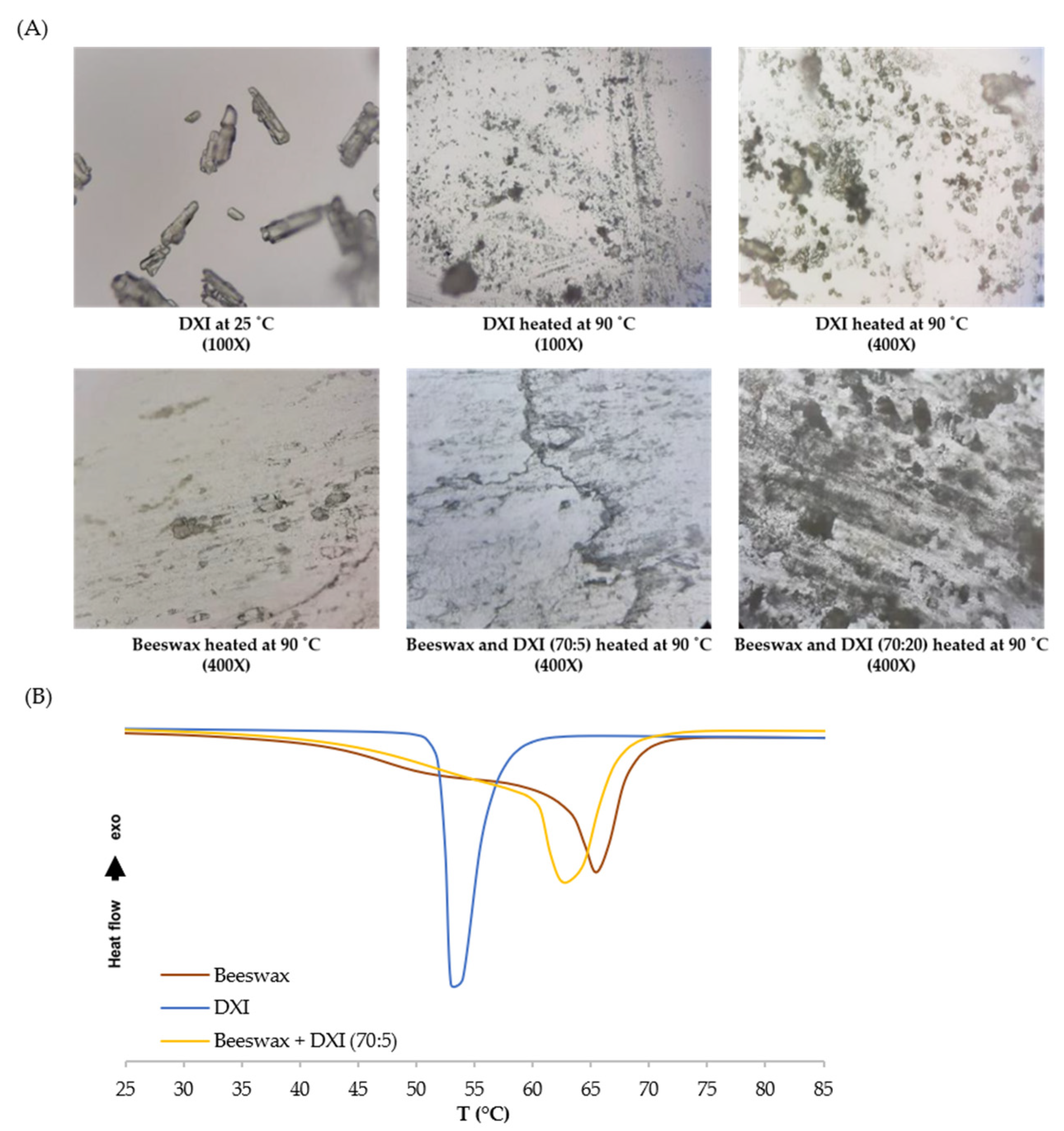
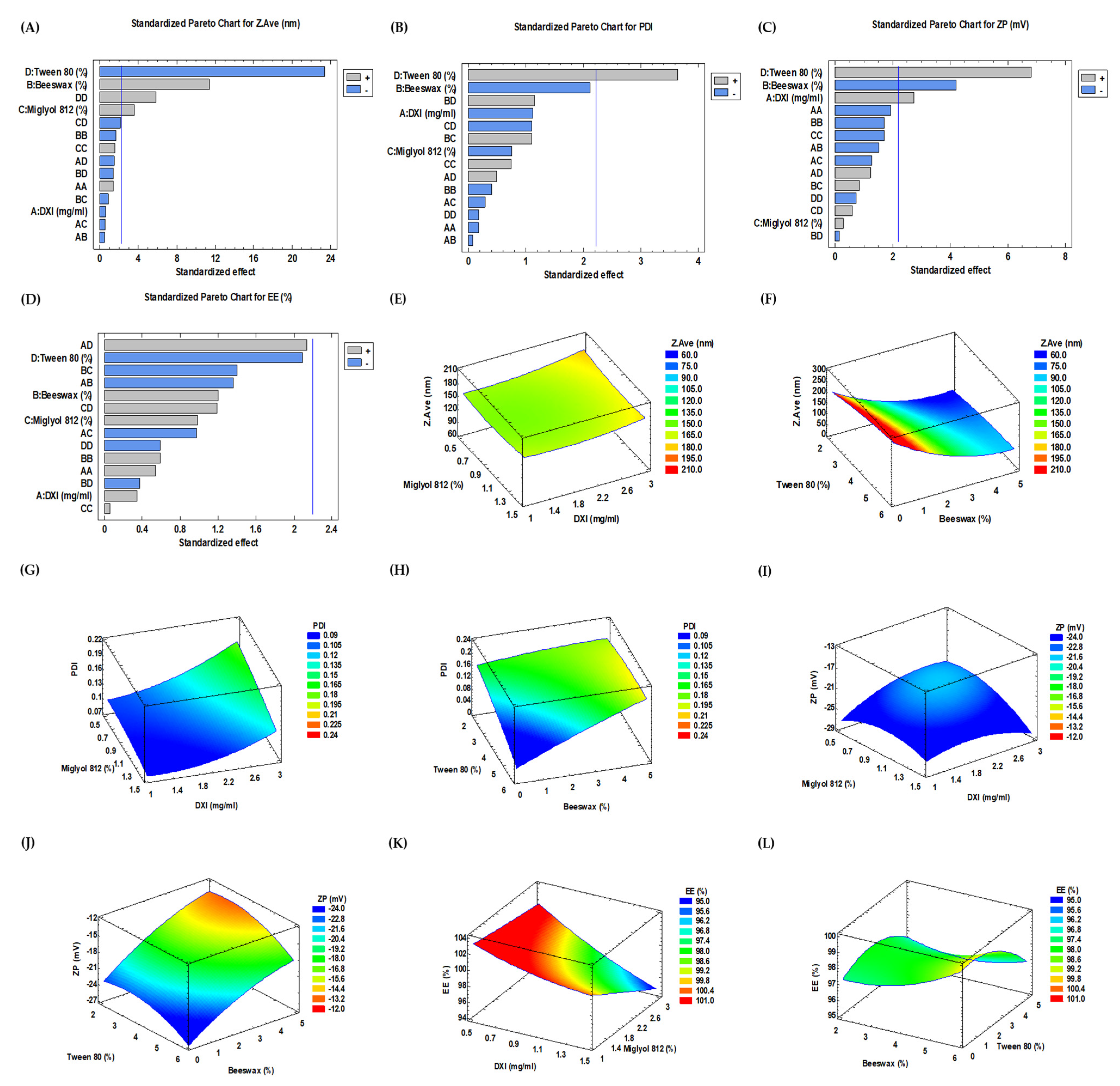

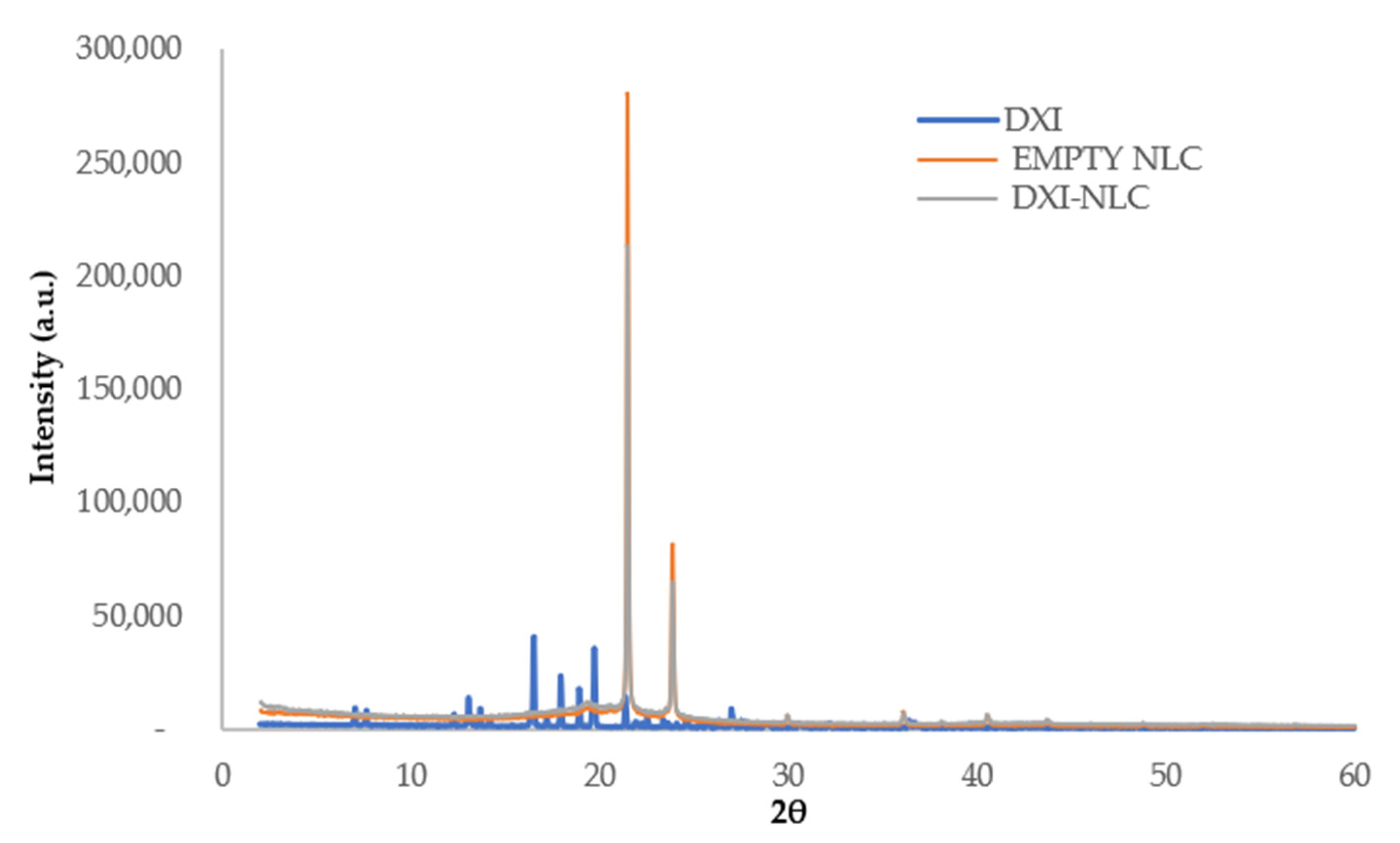
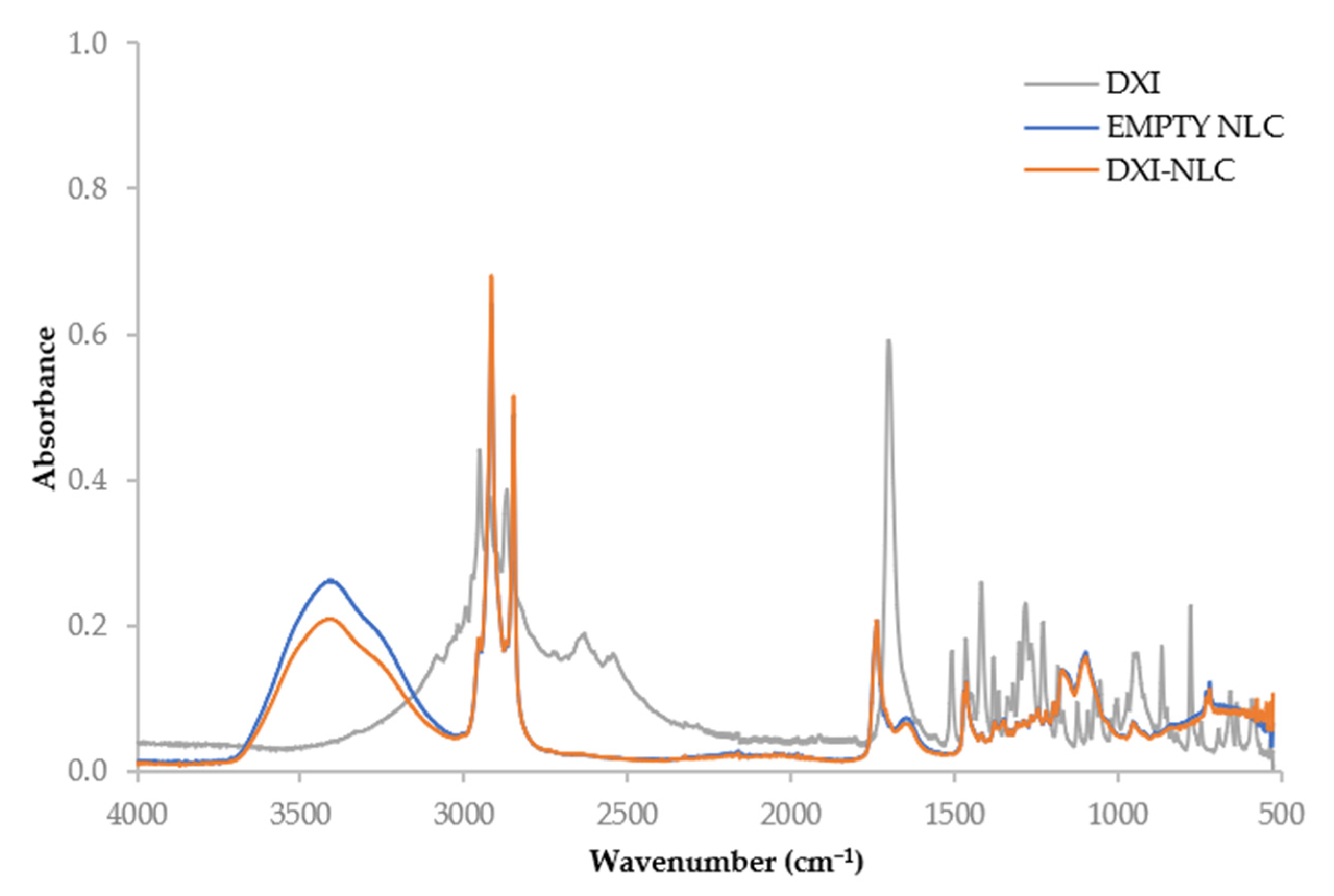
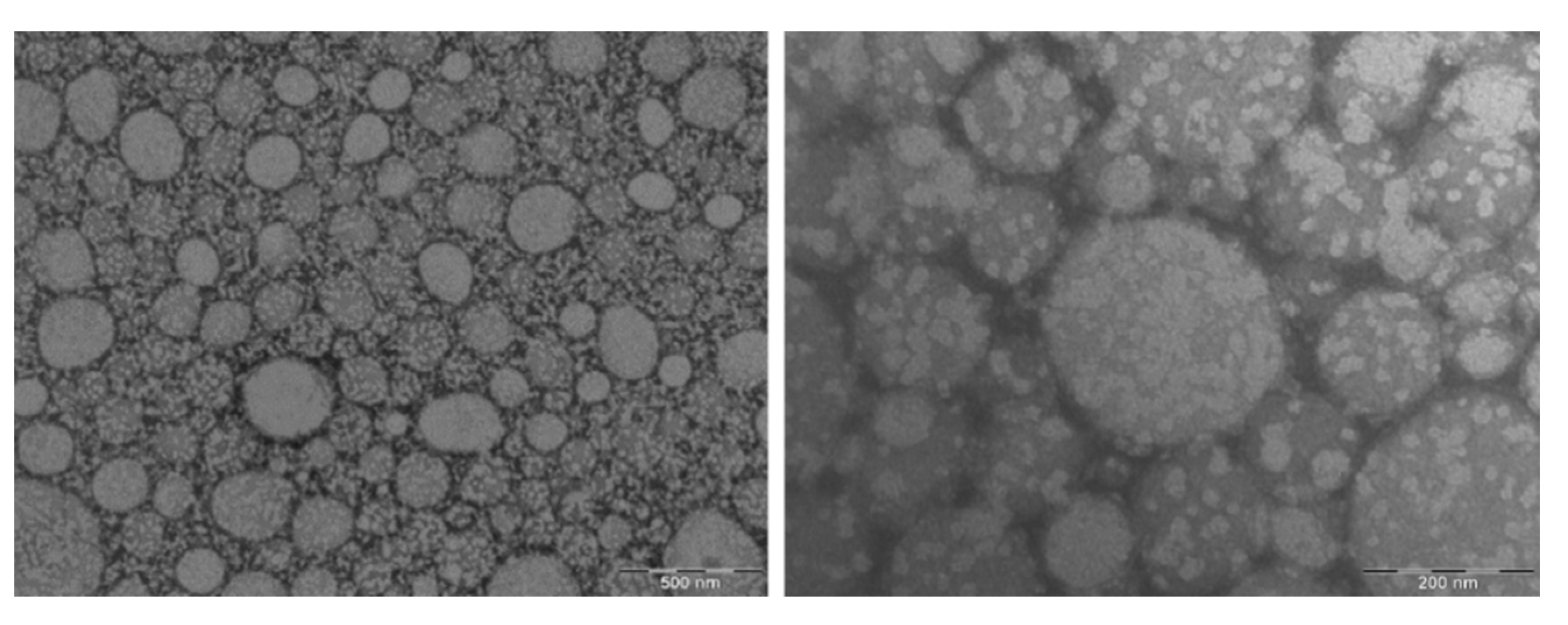
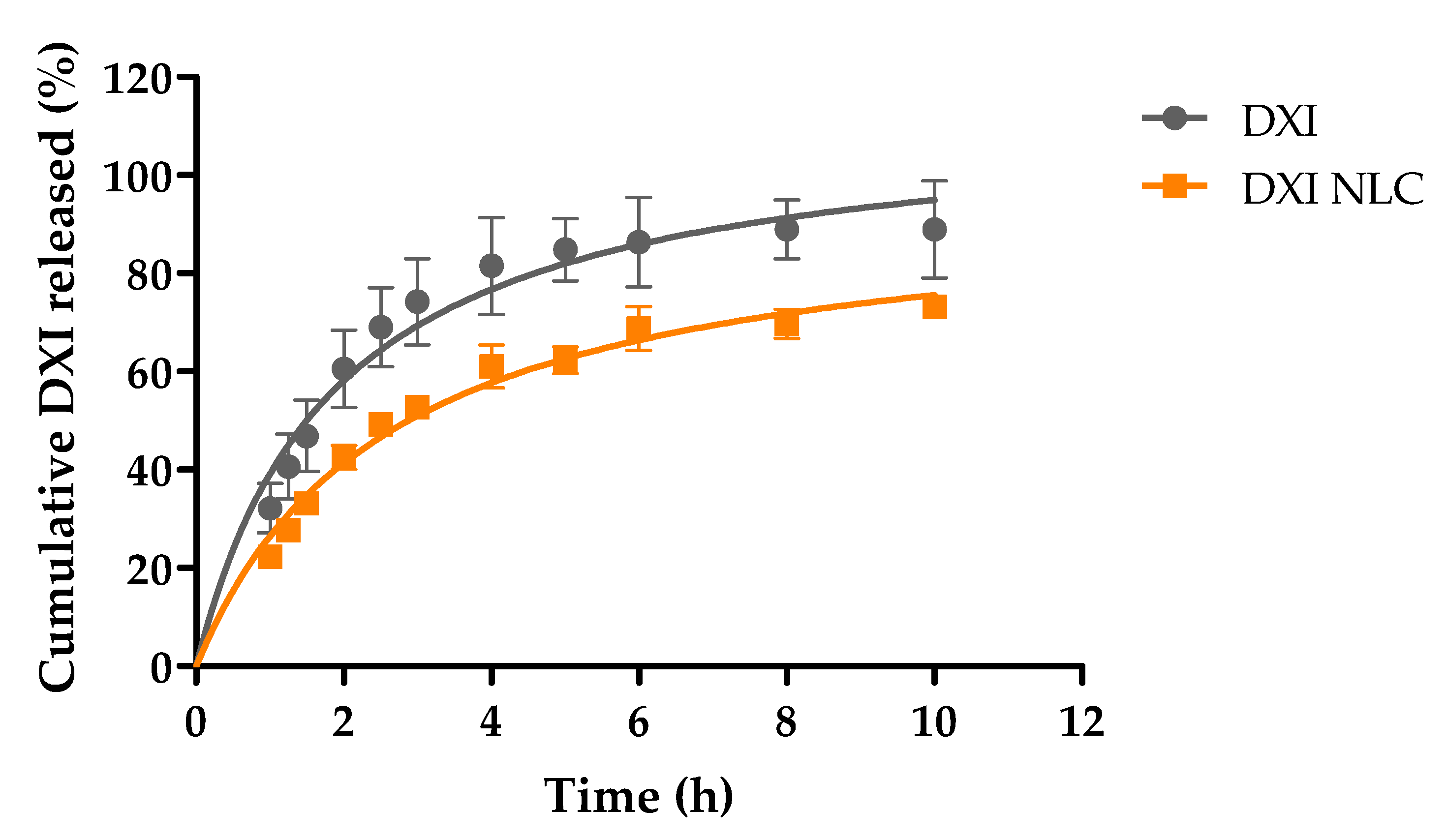
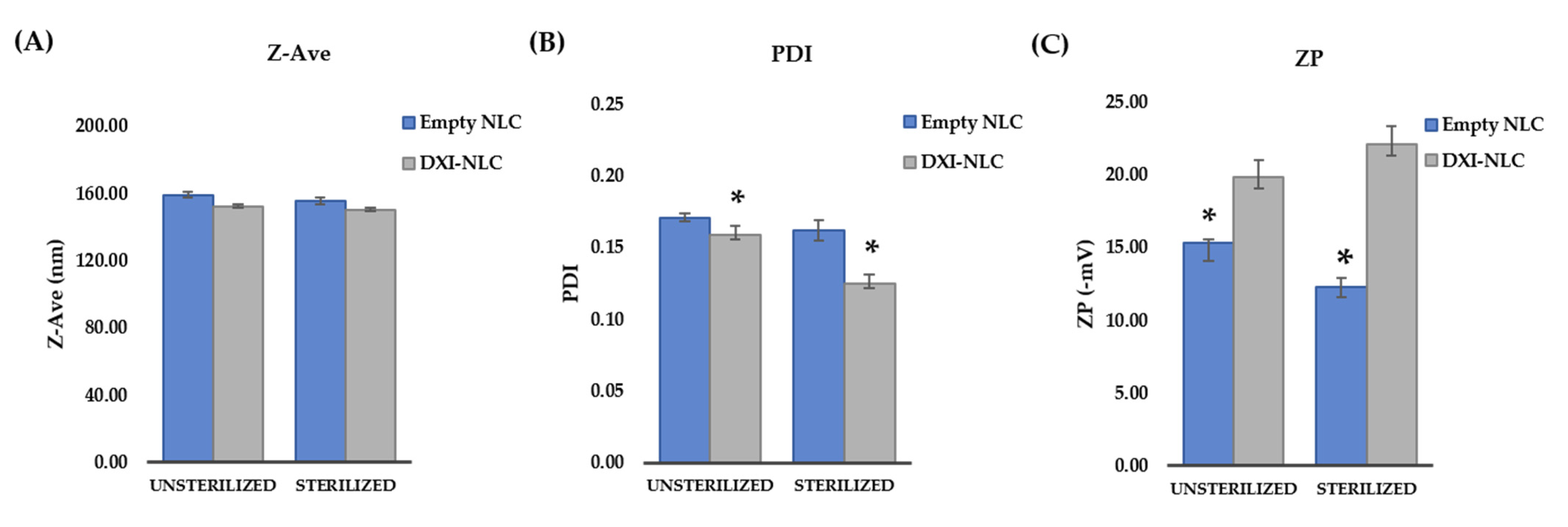
| Compounds | Concentrations of Selected Excipients | |
|---|---|---|
| Preformulation A | Preformulation B | |
| DXI (mg/mL) | 1 | 1 |
| Beeswax (%) | 4 | 4 |
| Castor oil (%) | 2 | 0 |
| Miglyol 812 (%) | 0 | 2 |
| Tween 80 (%) | 3 | 3 |
| Preformulation | Zave (nm) | PDI | ZP (mV) | EE (%) |
|---|---|---|---|---|
| A | 129.8 ± 1.3 | 0.232 ± 0.025 | −18.9 ± 0.5 | 96.94 |
| 123.1 ± 0.6 | 0.223 ± 0.021 | −17.7 ± 0.3 | 96.89 | |
| B | 103.8 ± 1.1 | 0.171 ± 0.019 | −15.9 ± 0.2 | 97.02 |
| 92.35 ± 2.32 | 0.188 ± 0.012 | −14.8 ± 0.3 | 95.69 |
| DXI | Beeswax | Miglyol 812 | Tween 80 | Parameters | ||||||||
|---|---|---|---|---|---|---|---|---|---|---|---|---|
| Coded Level | mg/mL | Coded Level | % | Coded Level | % | Coded Level | % | Zave (nm) | PDI | ZP (mV) | EE (%) | |
| Factorial Points | ||||||||||||
| F1 | 1 | 1.25 | 1 | 5 | 1 | 2.5 | 1 | 4 | 89.1 ± 1.09 | 0.17 ± 0.01 | −17.6 ± 2.91 | 98.96 |
| F2 | −1 | 0.75 | 1 | 5 | 1 | 2.5 | 1 | 4 | 103.9 ± 1.96 | 0.18 ± 0.03 | −16.5 ± 0.61 | 97.72 |
| F3 | 1 | 1.25 | −1 | 3 | 1 | 2.5 | 1 | 4 | 72.52 ± 0.84 | 0.18 ± 0.01 | −14.9 ± 2.01 | 98.87 |
| F4 | −1 | 0.75 | −1 | 3 | 1 | 2.5 | 1 | 4 | 77.43 ± 1.46 | 0.2 ± 0.01 | −15.6 ± 1.57 | 96.01 |
| F5 | 1 | 1.25 | 1 | 5 | −1 | 1.5 | 1 | 4 | 95.51 ± 0.06 | 0.19 ± 0.01 | −16.7 ± 1.65 | 97.14 |
| F6 | −1 | 0.75 | 1 | 5 | −1 | 1.5 | 1 | 4 | 98.25 ± 1.93 | 0.19 ± 0.05 | −18.7 ± 0.82 | 96.52 |
| F7 | 1 | 1.25 | −1 | 3 | −1 | 1.5 | 1 | 4 | 71.73 ± 0.59 | 0.13 ± 0.01 | −13.1 ± 2.46 | 97.91 |
| F8 | −1 | 0.75 | −1 | 3 | −1 | 1.5 | 1 | 4 | 70.25 ± 0.72 | 0.22 ± 0.01 | −16.7 ± 0.7 | 95.7 |
| F9 | −1 | 0.75 | 1 | 5 | 1 | 2.5 | −1 | 2 | 154.3 ± 2.44 | 0.15 ± 0.04 | −19.5 ± 0.51 | 98.96 |
| F10 | −1 | 0.75 | −1 | 3 | 1 | 2.5 | −1 | 2 | 126.9 ± 1.3 | 0.17 ± 0.01 | −20 ± 2.01 | 99.11 |
| F11 | −1 | 0.75 | 1 | 5 | −1 | 1.5 | −1 | 2 | 145.8 ± 0.58 | 0.12 ± 0.03 | −20.6 ± 0.4 | 99.48 |
| F12 | −1 | 0.75 | −1 | 3 | −1 | 1.5 | −1 | 2 | 112.6 ± 1.23 | 0.18 ± 0.01 | −17.8 ± 1.47 | 96.28 |
| F13 | 1 | 1.25 | 1 | 5 | 1 | 2.5 | −1 | 2 | 160.4 ± 1.43 | 0.12 ± 0.02 | −21.8 ± 2.66 | 96.09 |
| F14 | 1 | 1.25 | −1 | 3 | 1 | 2.5 | −1 | 2 | 129.7 ± 2.35 | 0.15 ± 0.01 | −18.1 ± 0.54 | 98.12 |
| F15 | 1 | 1.25 | 1 | 5 | −1 | 1.5 | −1 | 2 | 146.9 ± 0.98 | 0.09 ± 0.04 | −20.6 ± 0.76 | 99.88 |
| F16 | 1 | 1.25 | −1 | 3 | −1 | 1.5 | −1 | 2 | 112.7 ± 0.78 | 0.17 ± 0.03 | −18.1 ± 0.7 | 97.46 |
| Axial Points | ||||||||||||
| F17 | −2 | 0.5 | 0 | 4 | 0 | 2 | 0 | 3 | 108.70 ± 1.82 | 0.17 ± 0.01 | −21.7 ± 1.48 | 99.29 |
| F18 | 2 | 1.5 | 0 | 4 | 0 | 2 | 0 | 3 | 106.7 ± 0.89 | 0.17 ± 0.02 | −15.9 ± 0.53 | 97.87 |
| F19 | 0 | 1 | 0 | 4 | 0 | 2 | 2 | 5 | 78.94 ± 1.56 | 0.18 ± 0.02 | −14.1 ± 0.51 | 96.3 |
| F20 | 0 | 1 | 0 | 4 | 2 | 3 | 0 | 3 | 116.7 ± 1.01 | 0.18 ± 0.01 | −17.7 ± 0.38 | 98.52 |
| F21 | 0 | 1 | 0 | 4 | −2 | 1 | 0 | 3 | 100 ± 3.07 | 0.2 ± 0.03 | −19.4 ± 0.06 | 97.65 |
| F22 | 0 | 1 | 2 | 6 | 0 | 2 | 0 | 3 | 112.1 ± 2.12 | 0.17 ± 0.02 | −20.3 ± 0.38 | 98.89 |
| F23 | 0 | 1 | −2 | 2 | 0 | 2 | 0 | 3 | 71.86 ± 0.41 | 0.16 ± 0.08 | −16.8 ± 0.22 | 98.37 |
| F24 | 0 | 1 | 0 | 4 | 0 | 2 | −2 | 1 | 182.8 ± 0.27 | 0.16 ± 0.02 | −20.8 ± 0.27 | 98.54 |
| Central Points | ||||||||||||
| F25 | 0 | 1 | 0 | 4 | 0 | 2 | 0 | 3 | 110.4 ± 2.03 | 0.16 ± 0.03 | −15.6 ± 0.31 | 97.2 |
| F26 | 0 | 1 | 0 | 4 | 0 | 2 | 0 | 3 | 91.75 ± 1.77 | 0.18 ± 0.01 | −17 ± 0.72 | 98.3 |
| Parameters | Predicted Values | Experimental Values |
|---|---|---|
| Zave (nm) | ~150 | 152.3 ± 1.6 |
| PDI | <0.18 | 0.149 ± 0.03 |
| ZP (mV) | −20 | −19.8 ± 0.764 |
| EE (%) | >95 | 99.17 |
| Parameters | DXI | DXI-NLC |
|---|---|---|
| Bmax ± SD (%) | 118.30 ± 5.75 | 91.09 ± 3.14 |
| Kd ± SD (h) | 2.24 ± 0.28 | 2.90 ± 0.22 |
| R2 value | 0.9264 | 0.9763 |
| Day | T (°C) | Zave (nm) | PDI | ZP (mV) |
|---|---|---|---|---|
| 0 | 4 | 152.3 ± 1.6 | 0.149 ± 0.03 | −19.8 ± 0.76 |
| 25 | 152.3 ± 1.6 | 0.149 ± 0.03 | −19.8 ± 0.76 | |
| 37 | 152.3 ± 1.6 | 0.149 ± 0.03 | −19.8 ± 0.76 | |
| 30 | 4 | 152.6 ± 2.1 | 0.145 ± 0.01 | −19.2 ± 0.53 |
| 25 | 150.7 ± 2.4 | 0.143 ± 0.02 | −19.6 ± 0.4 | |
| 37 | 152.4 ± 2.9 | 0.143 ± 0.02 | −18 ± 0.17 | |
| 60 | 4 | 149.8 ± 0.8 | 0.158 ± 0.01 | −22.5 ± 0.15 * |
| 25 | 150.9 ± 1.9 | 0.140 ± 0.04 | −21.6 ± 0.17 * | |
| 37 | 150.4 ± 1 | 0.158 ± 0.01 | −17.4 ± 0.4 * |
| Formulation | IC50 (µM) | |||||
|---|---|---|---|---|---|---|
| PC-3 | MDA-MB-468 | |||||
| 24h | 48h | 72h | 24h | 48h | 72h | |
| Empty NLC | 28.5 ± 4.3 | 14.9 ± 5.6 | 12.9 ± 1.3 | 42.5 ± 11.8 | 69.6 ± 27.5 | 11.6 ± 6.7 |
| DXI-NLC | 10.1 ± 3.1 | 72.9 ± 21.3 | 60.8 ± 10.3 | 3.4 ± 0.4 | 82.4 ± 65.2 | 66.1 ± 22.4 |
| Compounds | Levels | ||||
|---|---|---|---|---|---|
| −2 | −1 | 0 | 1 | 2 | |
| DXI (mg/mL) | 0.5 | 0.75 | 1 | 1.25 | 1.5 |
| Beeswax (%) | 2 | 3 | 4 | 5 | 6 |
| Miglyol (%) | 1 | 1.5 | 2 | 2.5 | 3 |
| Tween 80 (%) | 1 | 2 | 3 | 4 | 5 |
Publisher’s Note: MDPI stays neutral with regard to jurisdictional claims in published maps and institutional affiliations. |
© 2022 by the authors. Licensee MDPI, Basel, Switzerland. This article is an open access article distributed under the terms and conditions of the Creative Commons Attribution (CC BY) license (https://creativecommons.org/licenses/by/4.0/).
Share and Cite
Thiruchenthooran, V.; Świtalska, M.; Bonilla, L.; Espina, M.; García, M.L.; Wietrzyk, J.; Sánchez-López, E.; Gliszczyńska, A. Novel Strategies against Cancer: Dexibuprofen-Loaded Nanostructured Lipid Carriers. Int. J. Mol. Sci. 2022, 23, 11310. https://doi.org/10.3390/ijms231911310
Thiruchenthooran V, Świtalska M, Bonilla L, Espina M, García ML, Wietrzyk J, Sánchez-López E, Gliszczyńska A. Novel Strategies against Cancer: Dexibuprofen-Loaded Nanostructured Lipid Carriers. International Journal of Molecular Sciences. 2022; 23(19):11310. https://doi.org/10.3390/ijms231911310
Chicago/Turabian StyleThiruchenthooran, Vaikunthavasan, Marta Świtalska, Lorena Bonilla, Marta Espina, Maria Luisa García, Joanna Wietrzyk, Elena Sánchez-López, and Anna Gliszczyńska. 2022. "Novel Strategies against Cancer: Dexibuprofen-Loaded Nanostructured Lipid Carriers" International Journal of Molecular Sciences 23, no. 19: 11310. https://doi.org/10.3390/ijms231911310
APA StyleThiruchenthooran, V., Świtalska, M., Bonilla, L., Espina, M., García, M. L., Wietrzyk, J., Sánchez-López, E., & Gliszczyńska, A. (2022). Novel Strategies against Cancer: Dexibuprofen-Loaded Nanostructured Lipid Carriers. International Journal of Molecular Sciences, 23(19), 11310. https://doi.org/10.3390/ijms231911310








